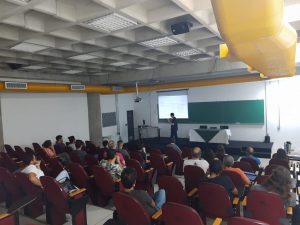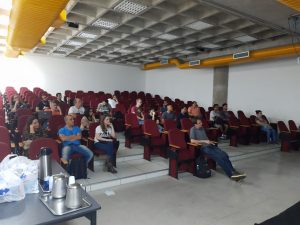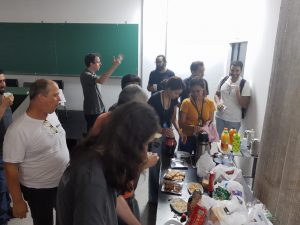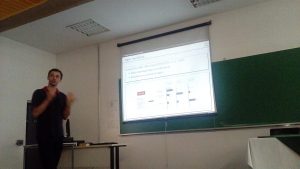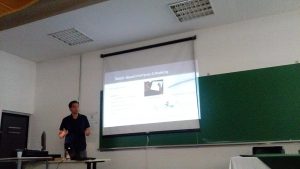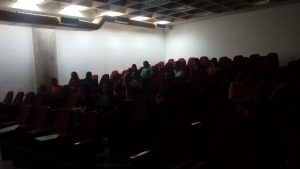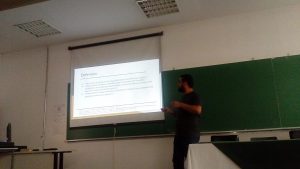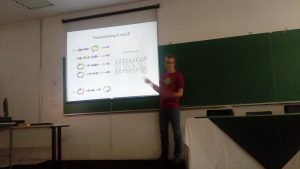O II Workshop André Balan de Pós-Graduação em Ciência da Computação é destinado a divulgação de pesquisas de alunos do Programa de Pós-Graduação em Ciência da Computação, além de contar com palestrantes externos renomados por suas vastas contribuições para a Ciência da Computação. O Workshop foi realizado em memória de André Balan e Mirtha Venero, ex-membros do Programa de Pós-Graduação em Ciência da Computação, lamentavelmente falecidos respectivamente em janeiro de 2018 e novembro de 2019.

O II Workshop André Balan foi realizado em 5 de dezembro de 2019, na sala S-212-0 do Bloco A, Santo André e contou com as seguintes palestras:
- 14:20 – Multiple views of text documents: what different perspectives can show us?
- Palestrante: Charles Henrique Porto Ferreira (aluno de doutorado)
- Resumo: Visual analytics is a relatively new term defined as the science of analytical reasoning supported by interactive visual interfaces. The necessity of such technology came from the massive amount and the complexity of data produced on a daily bases for the last few decades and thus hints at scalability issues in the analysis of such data sets. Visual analytics has applications in a verity of sectors, such as security, finance, and business. The first part of this talk gives a general overview of visual analytics, starting from the history of this term, along with its various types and their development methodologies (patch or traditional, progressive, predictive, immersive, among others). The second part presents some visual analytics applications and the difference they made in the subject field. The final part lists the challenges of visual analytics research and future trends.
- 15:00 – 3D reconstruction of single-view sketches and their biological applications
- Palestrante: Saulo Ramos de Carvalho Pereira (aluno de doutorado)
- Resumo: The 3D reconstruction from a single 2D single-view sketch faces challenges in capturing details of the curves and inferring the hidden parts. We introduced an approach that ensures the 2D contours are interpolated to a suitable 3D reconstruction while capturing the small details of the sketch. This approach was extended to an sketch-based interface that supports layering, open contours and stripes in order to allow artists and scientific illustrators create complex models from these drawings. Feasible 3D models are then generated using Hermitian Radial Basis Functions (HRBF) Implicit Surfaces and Rotational Blending Surfaces. Results indicate that our approach provides more detailed 3D reconstructed models in comparison to previous work and presents 3D models reconstructed inspired in complex drawings usually employed in scientific illustrations.
- Palestrante: Saulo Ramos de Carvalho Pereira (aluno de doutorado)
- 15:40 – An overview of Visual Analytics
- Palestrante: Muhsen Hammoud (aluno de doutorado)
- Resumo: Visual analytics is a relatively new term defined as the science of analytical reasoning supported by interactive visual interfaces. The necessity of such technology came from the massive amount and the complexity of data produced on a daily bases for the last few decades and thus hints at scalability issues in the analysis of such data sets. Visual analytics has applications in a verity of sectors, such as security, finance, and business. The first part of this talk gives a general overview of visual analytics, starting from the history of this term, along with its various types and their development methodologies (patch or traditional, progressive, predictive, immersive, among others). The second part presents some visual analytics applications and the difference they made in the subject field. The final part lists the challenges of visual analytics research and future trends.
- 16:40 – Genome rearrangement by double cut and join
- Palestrante: Jens Stoye (Bielefeld University – Alemanha)
- Resumo: Genome evolution on the basis of gene order has been modeled by a variety of rearrangement operations such as inversions, translocations, transpositions, block interchanges, fusions and fissions. The double cut and join (DCJ) operation, introduced by Yancopoulos et al. (2005), allows to model all these classical operations while allowing for very simple algorithms, compared to earlier ones for more restricted models.
